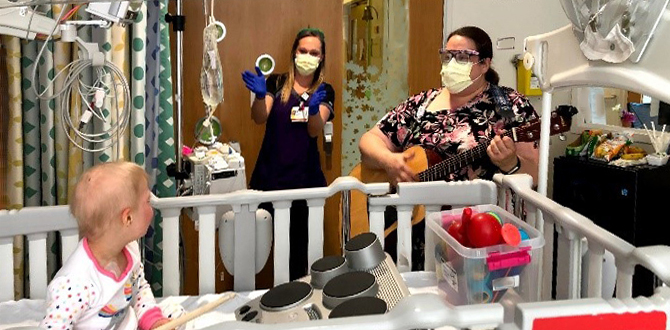Music Therapy

About Our Music Therapy Program
Established in 1997, the music therapy program at Golisano Children’s Hospital serves over 900 pediatric patients annually, at no cost to patients. Music therapy services are available on all inpatient units, including the Neonatal Intensive Care Units, Pediatric Intensive Care Unit (6 North), Pediatric Cardiac Care Center (6 South), 7 North, 7 South, 8 North, and 8 South. Since 2002, our music therapy program has served as a clinical practicum and university-affiliated internship site for bachelors and masters level students in an accredited music therapy program.
Music therapists at Golisano Children’s Hospital are trained and certified to work with children and adolescents with a variety of acute and chronic illnesses. From birth to young adulthood, they help patients cope with and process their hospitalization through passive and active music listening or music creation. They may also provide procedural support for patients undergoing procedures.
Patients must be referred to music therapy by any member of their healthcare team (doctors, nurses, child life specialists, occupational therapists, physical therapists and more) and can be requested by patients and families. Music therapy is standardly offered to any patient being treated by the Pediatric Hematology/Oncology Team when they are admitted to the hospital, as well as those admitted to the Child and Adolescent Eating Disorders Program. Group music therapy sessions are offered in our play areas weekly for any patient able to attend.
Currently, our music therapy team provides services 9:00 a.m. – 5:30 p.m., Monday-Friday.
Goals
Music therapists develop specific treatment goals based on patient and family input and feedback from the healthcare team. These may include:
- Help children and adolescents cope with their hospitalization by empowering them to explore and/or learn an instrument to increase self-esteem and independence.
- Provide a sense of normalization by engaging in developmentally appropriate musical play (i.e., color identification, counting, sharing).
- Offer guided relaxation paired with live or recorded music to assist with pain, nausea, or anxiety management, and promote mindfulness or relaxation.
- Compliment occupational therapy, physical therapy, and speech and language pathology goals by pairing musical interventions with movement or speech needs to either improve or maintain current levels of functioning.
- Facilitate growth and development through auditory, visual, vestibular (movement), and tactile stimulation.
- Increase socialization or decrease isolation through either individual or group music therapy sessions, which provide opportunities for collaborative music making.
- Help process emotions about hospitalization or illness through verbal or nonverbal interventions, such as songwriting, lyric discussion, or musical improvisation.
The hospital is an ever-changing environment and music therapists seek to reflect this in their care. Goals are adapted to each child or adolescent’s unique circumstances and abilities. The resulting music experiences are designed to facilitate changes that are nonmusical in nature.
Services
The music therapy program uses music to complement the healing process by addressing physical, emotional, cognitive, or social needs of patients, while also improving their quality of life and sense of wellness. Most music therapy is provided one-on-one in the patient’s room. Parents and siblings are encouraged to participate when they can and when appropriate. Music therapy sessions may also occur during outpatient visits, or in other areas of the hospital, depending on availability of the music therapists and/or music therapy interns.
The music therapy program also recognizes the importance of peer socialization and the power of music to bring community together. In light of this, they offer regularly scheduled music groups through Child Life Programming. These groups include:
- Wee Bee Jammin’: Weekly music group on Thursdays from 11:00 a.m. – 12:00 p.m. on the 7th floor Play Deck for patients from birth to 6 years old. Activities include singing familiar children’s songs, instrument play, musical games, or movement to music.
- *School Age Rock: Weekly music group for patients aged 7-12 on Fridays from 10:30 a.m. – 11:00 a.m. on the 7th floor Play Deck. Activities include music listening, instrument exploration and play, musical games, group drumming, or group songwriting.
- Teen Music Group: Weekly music group for patients aged 12 and older on Mondays from 3:00 p.m. – 4:00 p.m. in the 8th floor Teen Lounge. Activities include musical games, group songwriting, song discussion, group drumming, or music-based art creation.
- *Open Mic Night: Offered on the 4th Thursday of the month (except during flu season) in the GCH lobby (1st floor) from 4:00 p.m. – 5:00 p.m. for any patients, family members, friends, or hospital staff that want to share a talent or cheer others on.
* Group programming is currently on hold due to COVID-19 pandemic restrictions.
Music Therapy in the NICU
The Neonatal Intensive Care Unit at Golisano Children’s Hospital is the only NICU in upstate New York to offer music therapy services. NICU music therapy services began in 2017 and approximately 100 NICU patients have benefitted from music therapy services per year. Services are available for premature infants and their families at 26 weeks gestational age, when medically stable and with a physician’s order.
The NICU Music Therapist provides live music that is appropriate for premature infant’s tolerance level based on evidence-based research. Some NICU Music Therapy interventions include:
- Live/Localized Singing: Includes the use of live human voice to promote growth and neurologic development, stabilize behavior states, deepen sleep, reduce physiological and behavioral lability, and provide auditory respite from noise-induced stress.
- Musical Entrainment: Involves live music paired with rocking, which is matched to the rhythm and speed of the infant’s breathing and movements. The therapist gradually changes the speed of the music to decrease agitation and increase relaxation.
- Multimodal Neurologic Enhancement: An evidence-based protocol that involves gradually layering auditory (singing/guitar), tactile (massage), visual (eye contact/lights), and vestibular (rocking) stimulation in a way that the infant tolerates the input without startling. This promotes neurological growth and development.
- Developmental Music Therapy: Promotes visual tracking, hand-eye coordination, and fine/gross motor skills through the use of various small instruments and song books.